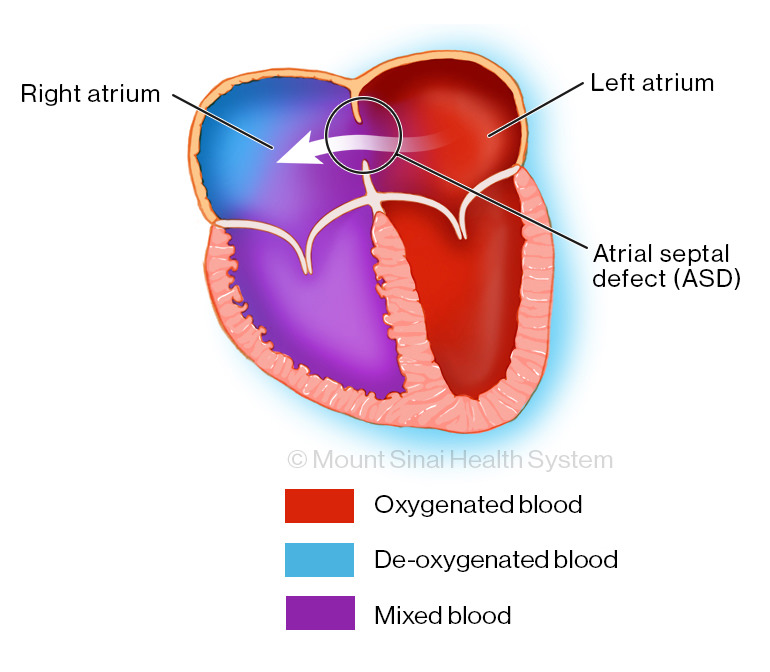Atrial Septal Defect
When you find out that your child has an atrial septal defect, also referred to as an ASD, you want to know how to take care of it, immediately. At Mount Sinai Children’s Heart Center, in partnership with Mount Sinai Fuster Heart Hospital, we get you in to see one of our expert pediatric cardiologists quickly. Our doctors specialize in treating babies and children with all types of heart conditions, including congenital (present at birth) heart defects like ASD.
We help you understand your child’s heart and how an ASD may affect his or her overall health. And we make sure that your child gets an accurate diagnosis and the treatment needed. That’s what we’re here for.
About Atrial Septal Defect (ASD)
An atrial septal defect (ASD) is a hole between the two upper chambers of the heart (the atria). An ASD occurs when the wall between the right atrium and the left atrium does not form completely. Larger ASDs allow too much blood to flow from the left atrium to the right atrium, and that extra blood goes to the lungs.

Just as each child is unique, each ASD is unique to that child. Treatment depends on the size and location of the hole in the atrial wall.
Most ASDs are:
- Secundum defects—holes usually located in the center of the atrial septum (the wall that separates the heart’s left and right sides)
Other types of ASDs include:
- Sinus venous defects—holes located at the edge of the atrial septum. Sinus venous defects often involve abnormal drainage of the pulmonary veins (vessels that bring blood back from the lungs to the heart)
- Primum defects—part of a partial atrioventricular canal defect, Primum defects involve a cleft leaflet (a split in the tissue) of the mitral valve (located between the left upper and left lower chambers of the heart)
Symptoms
Many children with an atrial septal defect have no symptoms at all. However, other children may experience the following symptoms:
- Breathlessness
- Reduced tolerance for exercise in older children
- Struggling to feed and gain weight in babies
If your child has an ASD with extra blood flow to the lungs, this may produce a heart murmur, which is a whooshing sound in the heart that your child’s doctor can detect during a routine checkup.
While your child may have no symptoms of an ASD, we may recommend repair for defects that are large enough to cause too much blood to go to the lungs. We usually recommend repair during early childhood. If left untreated, a child may eventually develop an abnormal heart rhythm or high pressure in the lungs, and early repair can prevent that. Once a child develops this abnormal heart rhythm, it is difficult to treat, even if the ASD is closed.
Diagnosis
To diagnose an ASD and determine the exact size and location of the hole, your child will have some of the following tests:
- Echocardiogram—a safe, noninvasive procedure that uses ultrasound waves to create an image of the size, shape, and movement of your child’s heart, valves, and chambers along with how blood flows through (also called an echo or cardiac ultrasound)
- Electrocardiogram (ECG or EKG)—a record of the electrical activity or rhythm of the heart that shows how your child’s heart is beating. It is non-invasive and obtained by placing stickers on your child’s chest.
- Cardiac MRI—an imaging test that uses safe, powerful magnets and radio waves to create pictures of your child’s heart, sometimes used in sinus venosus defects, a type of ASD.
Treatments We Offer
Many small ASDs may close on their own and require no treatment. Even if small ASDs do not close on their own, they usually don’t need treatment because they do not allow excessive blood to go to the lungs.
For larger holes, that allow excessive blood to go to the lungs, there are two ways to close them, cardiac catheterization, and surgery.
We can close secundum ASDs with a heart catheterization. However, if your child has a very large or more complex secundum ASDs, we may need to perform surgery to close them.
Other types of ASDs that require surgical closure include sinus venous ASDs and primum ASDs.
- Cardiac catheterization—a minimally invasive procedure. We insert a thin, flexible tube (catheter) through the groin into a blood vessel and up to the heart. Through the catheter, our interventional cardiologist places a device in the hole to seal it.
- Open heart surgery—a procedure that uses a heart-lung machine to maintain the function of your child’s heart and lungs. Our surgeon closes the ASD by sewing a patch in the hole, or sewing the hole shut. Once the blood starts flowing normally, we no longer need to use the heart-lung machine since your child’s heart is beating strongly.
Successful closure of your child’s ASD will restore the heart’s normal blood flow.
Additional procedures or interventions should not be necessary. However, we advise you to you continue follow-up care with your child’s pediatric cardiologist. At Children’s Heart Center, we are always available to care for your child.
Why Choose Children’s Heart Center?
At Mount Sinai, our pediatric cardiologists are highly experienced in diagnosing, monitoring, and treating childhood heart disorders, including atrial septal defects. We are available to meet with you at your convenience to explain your child’s condition and your options for care. We treat your child with tenderness and expertise, and we offer comfort and compassion to you and your family as you focus on the health of your child.
Our Children’s Heart Center in New York City offers the finest and most personalized care for your child, achieving outstanding results. Here, you know your child is in good hands.
